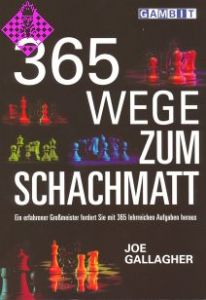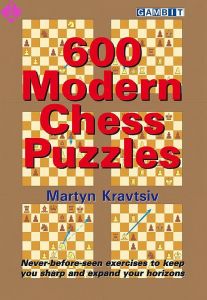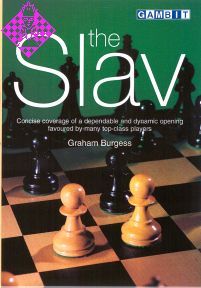Artikelnummer
LOBURTS
Autor
The Slav
256 Seiten, kartoniert, Gambit, 1. Auflage 2001
Final vergriffen
The Slav has been played by 11 of the first 13 World Champions, and has been favoured by many stars of modern chess, including Anand, Kramnik, Shirov, Ivanchuk and Morozevich. Its great popularity is due to its extreme solidity and abundant possibilities for dynamic counterplay.
This book provides detailed coverage to help players as both White and Black face the challenges of this tough yet rewarding opening. All lines after 1 d4 d5 2 c4 c6 are discussed, except those that transpose to the Semi-Slav.
The sharpest tactical lines of the Slav receive especially detailed coverage. These include the critical piece sacrifice in the main line (5...Bf5 6 Ne5 e6 7 f3 Bb4 8 e4 Bxe4), the Steiner line (5...Bg4) with 6 Ne5 Bh5 7 h3, and the possibly dubious but highly dangerous Geller Gambit (5 e4), which was a favourite of the young Kasparov. The trendy ...a6 lines are also covered systematically for the first time in chess literature.
This book provides detailed coverage to help players as both White and Black face the challenges of this tough yet rewarding opening. All lines after 1 d4 d5 2 c4 c6 are discussed, except those that transpose to the Semi-Slav.
The sharpest tactical lines of the Slav receive especially detailed coverage. These include the critical piece sacrifice in the main line (5...Bf5 6 Ne5 e6 7 f3 Bb4 8 e4 Bxe4), the Steiner line (5...Bg4) with 6 Ne5 Bh5 7 h3, and the possibly dubious but highly dangerous Geller Gambit (5 e4), which was a favourite of the young Kasparov. The trendy ...a6 lines are also covered systematically for the first time in chess literature.
The Slav has been played by 11 of the first 13 World Champions, and has been favoured by many stars of modern chess, including Anand, Kramnik, Shirov, Ivanchuk and Morozevich. Its great popularity is due to its extreme solidity and abundant possibilities for dynamic counterplay.
This book provides detailed coverage to help players as both White and Black face the challenges of this tough yet rewarding opening. All lines after 1 d4 d5 2 c4 c6 are discussed, except those that transpose to the Semi-Slav.
The sharpest tactical lines of the Slav receive especially detailed coverage. These include the critical piece sacrifice in the main line (5...Bf5 6 Ne5 e6 7 f3 Bb4 8 e4 Bxe4), the Steiner line (5...Bg4) with 6 Ne5 Bh5 7 h3, and the possibly dubious but highly dangerous Geller Gambit (5 e4), which was a favourite of the young Kasparov. The trendy ...a6 lines are also covered systematically for the first time in chess literature.
This book provides detailed coverage to help players as both White and Black face the challenges of this tough yet rewarding opening. All lines after 1 d4 d5 2 c4 c6 are discussed, except those that transpose to the Semi-Slav.
The sharpest tactical lines of the Slav receive especially detailed coverage. These include the critical piece sacrifice in the main line (5...Bf5 6 Ne5 e6 7 f3 Bb4 8 e4 Bxe4), the Steiner line (5...Bg4) with 6 Ne5 Bh5 7 h3, and the possibly dubious but highly dangerous Geller Gambit (5 e4), which was a favourite of the young Kasparov. The trendy ...a6 lines are also covered systematically for the first time in chess literature.
| EAN | 9781901983449 |
|---|---|
| Gewicht | 325 g |
| Hersteller | Gambit |
| Breite | 14,5 cm |
| Höhe | 21 cm |
| Medium | Buch |
| Erscheinungsjahr | 2001 |
| Autor | Graham Burgess |
| Sprache | Englisch |
| Auflage | 1 |
| ISBN-10 | 1901983447 |
| ISBN-13 | 9781901983449 |
| Seiten | 256 |
| Einband | kartoniert |
| Diagramme | 240 |
| Name | Gambit Publications Ltd. |
|---|---|
| Adresse | 27 Queens Pine, Bracknell Berkshire RG12 OTL Großbritannien |
| Internet | www.gambitbooks.com |
| info@gambitbooks.com |
Verantwortlicher Importeuer:
| Name | Schachversand Niggemann |
|---|---|
| Adresse | Schadowstraße 5 48163 Münster Deutschland |
| info@schachversand.de | |
| Internet | www.schachversand.de |
04 Symbols
04 Bibliography
05 Introduction
11 1 3. Nc3 and the Exchange Variation without Nf3
50 2 3. Nf3: Deviations from the Main Lines
81 3 The Exchange Variation with Nf3
109 4 The Main Line ...a6 Slav
133 5 4.Nc3 dxc4 without 5. a4
156 6 5.a4 without 5. ...Bf5
178 7 6.Nh4 and the Dutch Variation
214 8 6.Ne5: Deviations from the Main Line
234 9 The Bishop Sacrifice
255 Index of Variations
04 Bibliography
05 Introduction
11 1 3. Nc3 and the Exchange Variation without Nf3
50 2 3. Nf3: Deviations from the Main Lines
81 3 The Exchange Variation with Nf3
109 4 The Main Line ...a6 Slav
133 5 4.Nc3 dxc4 without 5. a4
156 6 5.a4 without 5. ...Bf5
178 7 6.Nh4 and the Dutch Variation
214 8 6.Ne5: Deviations from the Main Line
234 9 The Bishop Sacrifice
255 Index of Variations
Wiewohl nicht mit großmeisterlichen Weihen ausgestattet, ist der Verfasser der vorliegenden Eröffnungsmonografie vielen schachliterarisch bewanderten Zeitgenossen spätestens seit anno 1997 ein Begriff, als aus Mister Burgess' Feder das Monumentalwerk The Mammoth Book of Chess entsprang. Ganz so voluminös ist seine Abhandlung über das Slawische Damengambit zwar nicht, was aber wohl vorrangig daran liegt, dass sich der Autor streng an das vorgegebene Thema gehalten hat, d.h. affine und verwandte Systeme aus halbslawischen bzw. Meraner Gefilden wurden von vornherein eliminiert. Und so sind denn - frei übersetzt - folgende Kapitel „übrig" geblieben:
1. 3. Sc3 und die Abtausch-Variante ohne Sf3
2. 3. Sf3: Hauptvarianten-Abweichungen
3. Die Abtausch-Variante mit Sf3
4. Die Hauptvariante ...a6
5. 4. Sc3 dxc4 ohne 5. a4
6. 5. a4 ohne 5. ...Lf5
7. 6. Sh4 und Holländische Variante
8. 6. Sxe5: Abweichungen von der Hauptvariante
9. Das Läuferopfer
Die dargebotene Theorie reicht bis in das Jahr 2001 (!) und besteht größtenteils aus Partiefragmenten der letzten Dekade; komplette Partien sind lediglich insofern berücksichtigt worden, als sie innerhalb des eröffnungstheoretisch relevanten Zugzahllimits (also etwa innerhalb der ersten 20 Züge, wobei allerdings im Schlusskapitel auch umfänglicheres Material auftaucht) entschieden worden sind. Insofern fahndet ,man vergeblich nach Musterpartien, anhand derer die systemimmanenten Merkmale des slawischen Damengambits exemplarisch einstudiert werden könnten. Dass dies kein Nachteil sein muss, hat sich in der Praxis am Beispiel etlicher anderweitiger Publikationen aus Gegenwart und Vergangenheit allerdings längst bestätigt. Dies gilt umso mehr, als der Verfasser reichlich Text mit einfließen lässt und somit das Wesen der vorliegenden Verteidigung hinreichend illustriert. Die Eröffnung 1. d4 d5 2. c4 c6 ist seit den Zeiten eines Emanuel Lasker von zahlreichen Weltmeistern mit Erfolg praktiziert worden. Zur Zeit erlebt Slawisch gar eine Art zweiten (oder dritten?) Frühling durch Weltklassespieler wie Anand, Kramnik, Schirow, Iwantschuk oder Morozewitsch, die sich dieser Verteidigung häufig zu bedienen pflegen, ohne die unbestreitbaren Remistendenzen in der Abtauschvariante zu fürchten.
Für Turnierspieler etwa ab DWZ/Elo 2000 mit einschlägigem Repertoire und leidlichen Englischkenntnissen dürfte die Anschaffung des hochaktuellen Buches eine durchaus sinnvolle Angelegenheit sein. E. Carl, Rochade Europa 09/2001
1. 3. Sc3 und die Abtausch-Variante ohne Sf3
2. 3. Sf3: Hauptvarianten-Abweichungen
3. Die Abtausch-Variante mit Sf3
4. Die Hauptvariante ...a6
5. 4. Sc3 dxc4 ohne 5. a4
6. 5. a4 ohne 5. ...Lf5
7. 6. Sh4 und Holländische Variante
8. 6. Sxe5: Abweichungen von der Hauptvariante
9. Das Läuferopfer
Die dargebotene Theorie reicht bis in das Jahr 2001 (!) und besteht größtenteils aus Partiefragmenten der letzten Dekade; komplette Partien sind lediglich insofern berücksichtigt worden, als sie innerhalb des eröffnungstheoretisch relevanten Zugzahllimits (also etwa innerhalb der ersten 20 Züge, wobei allerdings im Schlusskapitel auch umfänglicheres Material auftaucht) entschieden worden sind. Insofern fahndet ,man vergeblich nach Musterpartien, anhand derer die systemimmanenten Merkmale des slawischen Damengambits exemplarisch einstudiert werden könnten. Dass dies kein Nachteil sein muss, hat sich in der Praxis am Beispiel etlicher anderweitiger Publikationen aus Gegenwart und Vergangenheit allerdings längst bestätigt. Dies gilt umso mehr, als der Verfasser reichlich Text mit einfließen lässt und somit das Wesen der vorliegenden Verteidigung hinreichend illustriert. Die Eröffnung 1. d4 d5 2. c4 c6 ist seit den Zeiten eines Emanuel Lasker von zahlreichen Weltmeistern mit Erfolg praktiziert worden. Zur Zeit erlebt Slawisch gar eine Art zweiten (oder dritten?) Frühling durch Weltklassespieler wie Anand, Kramnik, Schirow, Iwantschuk oder Morozewitsch, die sich dieser Verteidigung häufig zu bedienen pflegen, ohne die unbestreitbaren Remistendenzen in der Abtauschvariante zu fürchten.
Für Turnierspieler etwa ab DWZ/Elo 2000 mit einschlägigem Repertoire und leidlichen Englischkenntnissen dürfte die Anschaffung des hochaktuellen Buches eine durchaus sinnvolle Angelegenheit sein. E. Carl, Rochade Europa 09/2001
Mehr von Gambit
-
 101 Endspieltipps15,95 €
101 Endspieltipps15,95 € -
 125 Chess Opening Surprises19,50 €
125 Chess Opening Surprises19,50 € -
 365 Wege zum Schachmatt15,95 €
365 Wege zum Schachmatt15,95 € -
 A Complete Chess Course16,95 €
A Complete Chess Course16,95 € -
 101 Angriffsideen im Schach15,95 €
101 Angriffsideen im Schach15,95 € -
 50 Grundlegende Schachlektionen19,95 €
50 Grundlegende Schachlektionen19,95 € -
 600 Modern Chess Puzzles19,95 €
600 Modern Chess Puzzles19,95 € - Mehr von Gambit

